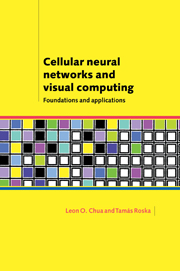Book contents
- Frontmatter
- Contents
- Acknowledgements
- 1 Introduction
- 2 Notation, definitions, and mathematical foundation
- 3 Characteristics and analysis of simple CNN templates
- 4 Simulation of the CNN dynamics
- 5 Binary CNN characterization via Boolean functions
- 6 Uncoupled CNNs: unified theory and applications
- 7 Introduction to the CNN Universal Machine
- 8 Back to basics: Nonlinear dynamics and complete stability
- 9 The CNN Universal Machine (CNN-UM)
- 10 Template design tools
- 11 CNNs for linear image processing
- 12 Coupled CNN with linear synaptic weights
- 13 Uncoupled standard CNNs with nonlinear synaptic weights
- 14 Standard CNNs with delayed synaptic weights and motion analysis
- 15 Visual microprocessors – analog and digital VLSI implementation of the CNN Universal Machine
- 16 CNN models in the visual pathway and the “Bionic Eye”
- Notes
- Bibliography
- Exercises
- Appendices
- Index
15 - Visual microprocessors – analog and digital VLSI implementation of the CNN Universal Machine
Published online by Cambridge University Press: 28 May 2010
- Frontmatter
- Contents
- Acknowledgements
- 1 Introduction
- 2 Notation, definitions, and mathematical foundation
- 3 Characteristics and analysis of simple CNN templates
- 4 Simulation of the CNN dynamics
- 5 Binary CNN characterization via Boolean functions
- 6 Uncoupled CNNs: unified theory and applications
- 7 Introduction to the CNN Universal Machine
- 8 Back to basics: Nonlinear dynamics and complete stability
- 9 The CNN Universal Machine (CNN-UM)
- 10 Template design tools
- 11 CNNs for linear image processing
- 12 Coupled CNN with linear synaptic weights
- 13 Uncoupled standard CNNs with nonlinear synaptic weights
- 14 Standard CNNs with delayed synaptic weights and motion analysis
- 15 Visual microprocessors – analog and digital VLSI implementation of the CNN Universal Machine
- 16 CNN models in the visual pathway and the “Bionic Eye”
- Notes
- Bibliography
- Exercises
- Appendices
- Index
Summary
Digital technology has the key advantage that if a few building blocks are implemented then any complex system can be built from these by
wiring and
programming.
Moreover, most of the digital building blocks are placed in a regular arrangement: a simple block is repeated many times in a matrix arrangement (e.g. memories, PLAs, etc.).
The CNN core and the CNN Universal Machine architecture, containing also analog building blocks, possess the very same properties. Due to their special nature, however, they have orders of magnitude advantages in speed, power, and area (SPA) in some standard physical implementations. In many applications, like image flow computing, this advantage might be mission critical.
As a revolutionary feature, stored programmability can be introduced in the analog domain as well. This makes it possible to fabricate visual microprocessors.
In what follows, first, we show the building blocks and their simple CMOS implementation examples, without going into the details of their design issues. The emulated digital implementation will be only briefly reviewed. As to this and the optical implementation, we refer to the literature.
As a summary: using only six simple circuit building blocks, namely:
resistor,
capacitor,
switch,
VCCS (Voltage Controlled Current Source),
logic register, and
logic gate,
the most complex CNN array computer chip can be built in a VLSI friendly, regular structure.
Next, the visual microprocessor and its computational infrastructure is described.
- Type
- Chapter
- Information
- Cellular Neural Networks and Visual ComputingFoundations and Applications, pp. 303 - 319Publisher: Cambridge University PressPrint publication year: 2002



